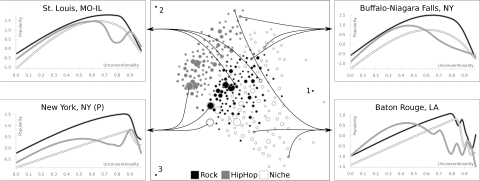Teaser

Description
Cities are breeding grounds of distinct modes of cultural activity. In this study, we examine how popular musicians define themselves differently depending on their location. In particular, we examine the relationship between bands’ degree of conventionality and unconventionality and their popularity. We show that this relationship in general exhibits a non-linear, inverted U pattern: extremely conventional bands are relatively unpopular, somewhat unconventional bands show more popularity, while the most unusual bands are not very popular.
However, this general pattern shifts, across musical genres and geography. Some cities show greater receptivity to unconventionality, with more unconventional bands achieving greater popularity, while in others more conventional bands tend to thrive. We examine several features of the urban environment that might explain these variations. We do so using a large database of nearly 3 million band profiles from myspace.com, circa 2007.
An interactive tool for exploring these relationships can be accessed here.



Leave a Reply
You must be logged in to post a comment.